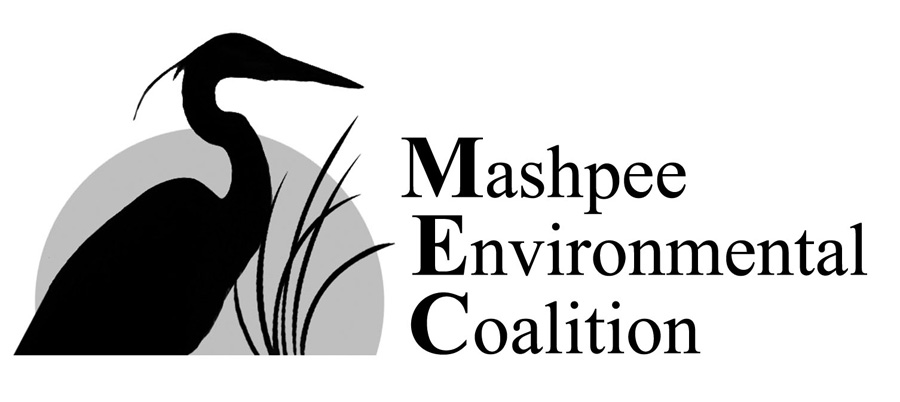by Virginia Scharfenberg | Mar 31, 2015 | Ecological Lawn Care, Waste Water
After overwhelming approval at Town Meeting, unanimous approval by the Cape Cod Commission and approval by the Attorney General, the Town of Mashpee has now added lawn fertilizer regulations to the Town Code. These regulations strongly recommend that only one to two pounds of nitrogen be applied per 1,000 square feet of lawn area. Phosphorus in lawn fertilizers should only be applied on new lawns or lawns where a soil test indicates a real need.
This Nitrogen Control Bylaw, Chapter 107 of the Town Code, as initially passed, includes the following performance standards that anyone who fertilizes their lawn areas must abide by: (more…)
by MEC | Jun 6, 2014 | Current Topics, Waste Water
The nutrient over-enrichment of our ponds and estuaries and the resultant noxious/harmful algae blooms that occur are fed, in a great degree, by the minimal treatment activity available from the many septic systems standard in our area. As the population grows the resultant sewage volume also grows increasing the intensity of the problem.
Over 30 years ago residents noted the declining water quality in our estuaries and engaged in a questioning and activism activity to understand and combat this obviously growing problem. Following a series of ″jawboning″ efforts and a series of town committees addressing the declining conditions a 1997 study was funded. That study confirmed the problem and established the need for a more in-depth review of the causal factors in order to develop a mitigation plan.
The Town of Mashpee Sewer Commission has undertaken the development of a a “Comprehensive Watershed Nitrogen and Wastewater Management Plan”. Baseline data for calendar year 2001 and data developed by Mashpee Volunteers beginning in 1997 with lab analyses by the School for Marine Science and Technology, UMASS, Dartmouth resulted in a 2004 technical report for Popponesset Bay followed a few years later for the Mashpee portion of Waquoit Bay. These reports were the basis for Massachusetts prepared documents outlining the current conditions and maximum levels allowable to restore our troubled waters. These reports known as ″Total Maximum Daily Loads″ are required by the Clean Water Act and must receive approval from the regional EPA to become an official regulatory requirement. This approval has been forthcoming.
Mashpee funded the remedial planning effort by over $500,000 ($405,140 authorized May and $40,000 authorized October of 1999), plus past and additional studies with continued volunteer water sampling mandating lab analyses. The planning is intended to provide a road-map to the eventual resolution to the serious and growing decay of our estuarine waters due to nutrient pollution.
An Environmental Notification Form (ENF) was submitted to the Executive Office of Environmental Affairs. The Secretary’s Certificate (November 9, 2001) requires a Draft and Final Environmental Impact Reports. The Certificate also notes the Project is subject to joint review with the Cape Cod Commission as a Development of Regional Impact. Engineering / Scientific Support Contracts have been negotiated and a “Community Advisory Committee” established.
The planning activity is ongoing at this time and has experienced significant difficulties along the way. One major glitch has been the reorganization of the Sewer Commission from a three member to a seven member Commission with only one of the original Commissioners retained. As infrastructure plans are developed they need to be tested by the scientific community for compliance to the computer models developed for our watersheds. At this time we have a mix of compliant and non-compliant potential approaches with costs that vary from approximately $250 million to $500 million.
In addition to the minor road blocks that should be anticipated for a project of this size and complexity, there are two major hurdles that should have been addressed long ago to establish a solid planning basis.
The first hurdle is the lack of any discussions towards an agreement from the watershed participants (Mashpee, Barnstable and Sandwich for Popponesset and Mashpee, Sandwich and Falmouth for Waquoit) relating to what share of each watershed´s allowable limit should be allotted to each watershed sharing town.
The second major hurdle is planning for acquiring the funding needed to design and construct the needed piping and treatment facilities. It appears the largest source of funding will be local and may be taxes, betterments, fees or other sources. As is likely, not all properties will require connection to a sewage treatment plant, yet theoretically all properties will benefit from restored and protected waters. This raises the question of who should pay and how.
Mashpee residents should learn all they can about this major endeavor that will have a major impact on their wallets and environmental ″Quality of Life″. MEC will continue to follow the progress of the wastewater remediation activity in Mashpee as a standard item in our quarterly newsletter.
